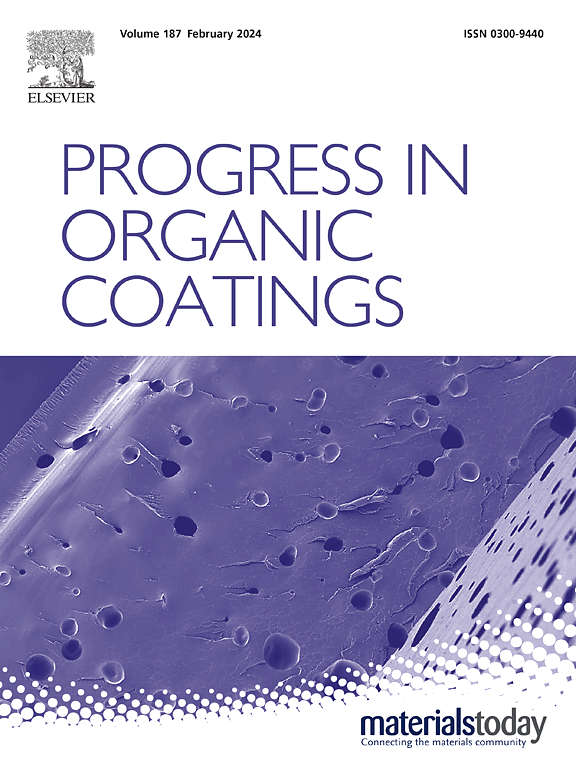将PANI@BTA@MSN介孔纳米杂化物集成到富锌环氧涂料中,实现长期智能防腐耐久性
IF 6.5
2区 材料科学
Q1 CHEMISTRY, APPLIED
引用次数: 0
摘要
富锌环氧涂料(ZRs)通过结合金属锌填料和有机屏障提供有效的阴极保护;然而,高锌填料负载的问题促使人们探索替代方法。本研究研究了一种新方法,将Pani@BTA@MSN复合材料加入ZR涂层中,以提高长期防腐耐久性。本文合成了一种介孔二氧化硅纳米颗粒(MSN),作为苯并三唑(BTA)和聚苯胺(PANI)的介孔载体,两者都有助于涂层的耐腐蚀性。利用FTIR、FESEM、BET、UV-Vis和TGA等技术对纳米杂化结构进行了表征。电化学分析,包括EIS和Tafel测试,表明PANI@BTA@MSN释放的抑制剂在盐水溶液中24 h后,|Z|10mHz值增加到2415 Ω·cm2,达到82%的缓蚀效率。此外,涂层阶段的EIS和OCP测试表明,完整的复合增强ZR涂层将阴极保护时间延长了10至20天。65天后,与纯ZR涂层相比,阻隔性能提高了一个数量级。FESEM/EDS图显示了保护层的形成,而拉脱附着力测试显示PANI@BTA@MSN-ZR涂层的附着力损失最小(5%),强调了其增强的阻隔性和活性防腐性能。本文章由计算机程序翻译,如有差异,请以英文原文为准。
Integrating PANI@BTA@MSN mesoporous nano-hybrid into zinc-rich epoxy coatings for long-term smart anti-corrosion durability
Zinc-rich epoxy coatings (ZRs) offer effective cathodic protection by combining metallic zinc fillers with organic barriers; however, issues with high zinc filler loading have prompted the exploration of alternative methods. This study investigates a novel approach, incorporating a Pani@BTA@MSN composite into ZR coatings to enhance long-term anti-corrosion durability. Here, a mesoporous silica nanoparticle (MSN) was synthesized as a mesoporous carrier for benzotriazole (BTA) and polyaniline (PANI), both of which contribute to the coating's corrosion resistance. The nano-hybrid structure was characterized using FTIR, FESEM, BET, UV–Vis, and TGA techniques. Electrochemical analyses, including EIS and Tafel tests, showed that inhibitor release from PANI@BTA@MSN increased |Z|10mHz values to 2415 Ω·cm2 after 24 h in saline solution, achieving an 82 % inhibition efficiency. Furthermore, EIS and OCP tests in the coating phase revealed that the intact composite-enhanced ZR coating extended cathodic protection from 10 to 20 days. After 65 days, the barrier performance improved by an order of magnitude compared to neat ZR coatings. FESEM/EDS mapping demonstrated the protective layer's formation, while pull-off adhesion tests showed minimal adhesion loss (5 %) in the PANI@BTA@MSN-ZR coating, underscoring its enhanced barrier and active anti-corrosion properties.
求助全文
通过发布文献求助,成功后即可免费获取论文全文。
去求助
来源期刊

Progress in Organic Coatings
工程技术-材料科学:膜
CiteScore
11.40
自引率
15.20%
发文量
577
审稿时长
48 days
期刊介绍:
The aim of this international journal is to analyse and publicise the progress and current state of knowledge in the field of organic coatings and related materials. The Editors and the Editorial Board members will solicit both review and research papers from academic and industrial scientists who are actively engaged in research and development or, in the case of review papers, have extensive experience in the subject to be reviewed. Unsolicited manuscripts will be accepted if they meet the journal''s requirements. The journal publishes papers dealing with such subjects as:
• Chemical, physical and technological properties of organic coatings and related materials
• Problems and methods of preparation, manufacture and application of these materials
• Performance, testing and analysis.
 求助内容:
求助内容: 应助结果提醒方式:
应助结果提醒方式:


